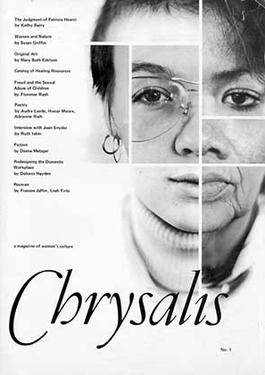Chrysalis (magazine)

Chrysalis: A Magazine of Women's Culture was a feminist publication produced from 1977 to 1980.[1][2] The self-published magazine was founded by Kirsten Grimstad and Susan Rennie at the Woman's Building in downtown Los Angeles. Chrysalis grew from Grimstad and Rennie's editorial work on the self-help resource books, and . Chrysalis distinguished itself from other feminist publications through an organic integration of politics, literature, cultural studies, and art. The magazine was produced through a collective process that grew out of the feminist practice of consciousness-raising. Unusually broad in scope, Chrysalis did not substitute breadth for quality. The authors, poets, essayists, and researchers contributing to the magazine reveal a veritable who's who of towering intellects of the feminist movement: black lesbian activist Audre Lorde; the magazine's poetry editor, Robin Morgan, who later served as editor of Ms. from 1990-1993: award winning poet Adrienne Rich; novelist Marge Piercy; artist Judy Chicago; science fiction writer Joanna Russ; art critic Lucy Lippard, plus Mary Daly, Dolores Hayden, Andrea Dworkin, Marilyn Hacker, Arlene Raven, and Elizabeth Janeway.[3] Over a three-year span, the all volunteer staff produced ten issues before they were forced to disband in 1981 due to financial difficulties.
Topics[]
Like the east coast publication Heresies: A Feminist Publication on Art and Politics, which was founded the same year, Chrysalis served the burgeoning second-wave feminist movement. Art historian Jenni Sorkin compares the legacy of the two, writing "While Heresies remains the better-known publication, it is Chrysalis that engaged a broader public, covering progressive issues that affected the women’s community at large without taking an insular view of art world-only politics, or the thematic issues for which Heresies became widely known."[4]
The editors of Chrysalis called the magazine "a vehicle for exploring the radical changes which women are initiating in the realms of theory and praxis."[5] The magazine explored a wide range of topics, including: ecology; Freud and sexual abuse of children; pornography; feminist theory; religion; lesbianism; feminist art and literature; and women’s domestic life. Volume 7 featured Adrienne Rich's important essay "'Disloyal to Civilization': Feminism, Racism, and Gynephobia."
References[]
- ^ Allen, Gwen (2011). Artists Magazines: An Alternative Space for Art. Cambridge, MA: The MIT Press. p. 249.
- ^ "Feminist art magazines or women artists magazines and newsletters". KT Press. Retrieved 27 October 2015.
- ^ Endres, Kathleen (1996). Women's Periodicals in the United States: Social and Political Issues. Greenwood. p. 59. ISBN 0313286329.
- ^ Sorkin, Jenni. "Second Life: Chrysalis". East of Borneo. Retrieved 9 March 2014.
- ^ Endres, Kathleen (1996). Women's Periodicals in the United States: Social and Political Issues. Greenwood. p. 58. ISBN 0313286329.
- 1977 establishments in California
- 1980 disestablishments in California
- Defunct women's magazines published in the United States
- Feminism in the United States
- Feminist magazines
- Independent magazines
- Magazines established in 1977
- Magazines disestablished in 1980
- Magazines published in Los Angeles